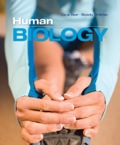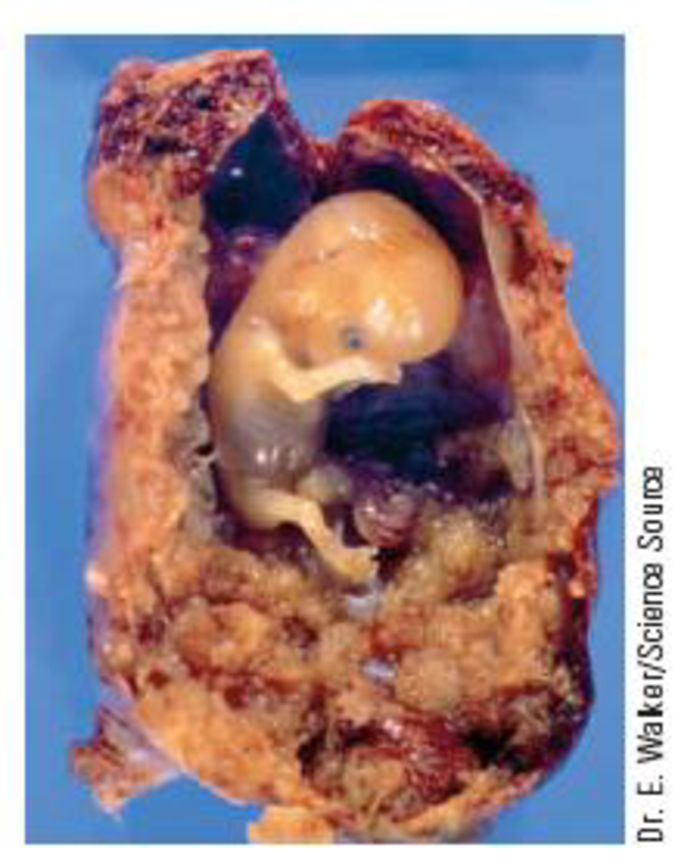
EBK HUMAN BIOLOGY
11th Edition
ISBN: 8220100545931
Author: MCMILLAN
Publisher: Cengage Learning US
expand_more
expand_more
format_list_bulleted
Textbook Question
Chapter 17, Problem 4CT
The complications of ectopic pregnancy (Section 17.2) are life-threatening for the mother, and in fact each year in the United States a few pregnant women die when their situation is not diagnosed in time. Tragically, the only option is to surgically remove the embryo, which was doomed from the beginning. Based on what you know about where an embryo normally develops, explain why the ectopic embryo in Figure 17.25 could not have long survived.

Figure 17.25 This embryo, the result of an ectopic pregnancy, could not survive implantation outside its mother’s uterus.
Expert Solution & Answer
Want to see the full answer?
Check out a sample textbook solution
Students have asked these similar questions
How does recent legislation on abortion (i.e, Texas making all abortions illegal once a fetal heartbeat is detected, with the exception of endangerment to the mother’s life) potentially violate the due proccess clause of the 14th amendment?
In-vitro fertilization occurs in the laboratory. The resulting embryos remain in a laboratory culture for up to six days before being transferred to the potential mother. If fertilization had occurred naturally (i.e., inside the female reproductive system instead of in-vitro), where would the embryo be and what developmental processes would it be undergoing during those first six days of development?
Suppose that in the near future, you are a prenatal care provider. In the most recent ultrasound checkup on the expecting mother, you unfortunately found that the fetus is suffering a neural tube defect in the form of anencephaly. Seeing as the mother is still in the 12th week of pregnancy or the 1st trimester, the pregnancy can still be terminated via medical means. How would you explain to the parents the situation they are in?
Chapter 17 Solutions
EBK HUMAN BIOLOGY
Ch. 17 - Define and describe the main features of the...Ch. 17 - Prob. 2RQCh. 17 - Summarize the development of an embryo and a...Ch. 17 - Label the early development stages shown in the...Ch. 17 - Prob. 1SQCh. 17 - During cleavage, the _______ is converted to a...Ch. 17 - Prob. 3SQCh. 17 - Prob. 4SQCh. 17 - _________ is the gene-guided process by which...Ch. 17 - In a human zygote, the cell divisions of cleavage...
Knowledge Booster
Learn more about
Need a deep-dive on the concept behind this application? Look no further. Learn more about this topic, biology and related others by exploring similar questions and additional content below.Similar questions
- In January 2009, Natalie Suleman successfully gave birth to octuplets and became known as Octomom. She already had 6 children, and all 14 of her children were conceived via in vitro fertilization (IVF). IVF involves removing eggs from the ovary, fertilizing them with sperm in a petri dish, and transferring the resulting embryos back into a uterus to develop. It is common for two or three embryos to be transferred into the uterus of a woman undergoing IVF to increase the chances of at least one of them surviving. When Ms. Suleman became pregnant with her octuplets, Dr. Kamrava had transferred 12 embryos. His license was revoked in 2011.Multiple eggs are required for IVF to produce functional embryos because some eggs are not fertilized or do not develop normally after fertilization. Which of the following hormones would be used to stimulate the ovaries to produce multiple eggs? Select one: a. Testosterone b. FSH c. Progesterone d. Estrogenarrow_forwardMaja Rotzky, a 19 y/o primigravid consultant, consulted on your clinic for her first prenatal check-up. The fundic height was measure to be at the level of umbilicus. Assuming that this is not multifetal pregnancy and there is no structural, or medical abnormality, approximately how many weeks AOG is this pregnancy? 18 weeks 20 weeks 12 weeks 24 weeks 16 weeksarrow_forwardWhy does testing for hCG (human chorionic gonadotropin)work as a pregnancy test early in pregnancy but not late inpregnancy? What is the function of hCG in pregnancy?arrow_forward
- You have an embryo in the eight-cell stage that shows radial and indeterminate cleavage. What would happen if you separated the cells of this embryo and placed them each into tissue culture media? Each cell may continue development, but only into a nonviable embryo that lacks many parts. Each cell may develop into a full-sized, normal embryo. All eight cells would die immediately. Each cell may deyelop into a smaller-than-average, but otherwise normal, embryo.arrow_forwardThere are 6 major events in fertilization. Discuss the process of fertilization or conception, with emphasis on the sperm-egg interaction. Proteins on the sperm plasma membrane bind to ZP3 molecules within the zona pellucida of the egg. Why is this event important? Zona binding triggers the acrosome reaction, in which the sperm plasma membrane fuses with the outer acrosomal membrane, causing exocytosis of acrosomal contents. What is in the "acrosomal content"? Acrosomal enzymes begin to dissolve a hole in the zona pellucida. This enzymatic degradation, accompanied by rapid sperm tail beating, moves the sperm through the zona. Where does the sperm intend to reach?arrow_forwardAfter fertilization a developing embryos goes through several changes. At about 2-3 days, what is the embryo referred to as?arrow_forward
- Which of the following statement does NOT correctly describe the event of the following fertilization? Select one: A. As hCG takes over maintaining the endometrium immediately after implantation, the corpus luteum degenerates into the corpus albican. B. All 16 cells in a morula are truly totipotent, meaning that they can become any cells in the human body. C. The trophoblast has important in maintaining the pregnancy, as it prevents the endometrium from shedding. D. Only inner cells mass in a blastocyst is pluripotent.arrow_forward10a) A female is exposed to a teratogen during the first and second month of pregnancy - before she even realizes she is pregnant. Which of the following birth defects might you expect to occur as a result? Defects of the eyes and ears Misformed or missing arms and/or legs Heart defects All of the above could possibly occur b) A female is exposed to a teratogen late in pregnancy, from the fourth month until birth. Which of the following birth defects might you expect to occur as a result? (Choose all that apply!) Heart defects Defects of the reproductive system Deformed or missing arms and/or legs Defects of the eyes and/or ears Learning disabilityarrow_forwardSome expensive home pregnancy tests claim to detect hCG as early as 5 days after conception ( when hCG are barely there). With the knowledge of how pregnancy tests work, please describe how a pregnancy test manufacturer could create such ultra sensitive test?arrow_forward
- Question:- There are specific critical periods during fetal development in which any damage caused to the fetus from malnutrition or exposure to toxins is irreversible. When do these periods occur? a) 3rd trimester b) 1st trimester c) 2nd trimester d) only at week 12 e) there are no critical periodsarrow_forwardRetinoic acid is the main component of Tretinoin, an anti-cancer chemotherapy drug. Retinoic acid is also a known teratogen which can cause congenital anomalies in eyes, ears, hearts, lungs, limbs, and many other organ systems. Based on the organ systems that are impacted by exposure to retinoic acid, during which of the following trimesters of pregnancy are developing humans most susceptible to the teratogenic effects of retinoic acid? aFirst trimester b.Second trimester c.Third trimesterarrow_forwardThere are 5 primary oocytes that will undergo cell division, How many functional egg cells will be viable for fertilization?arrow_forward
arrow_back_ios
SEE MORE QUESTIONS
arrow_forward_ios
Recommended textbooks for you
 Human Biology (MindTap Course List)BiologyISBN:9781305112100Author:Cecie Starr, Beverly McMillanPublisher:Cengage Learning
Human Biology (MindTap Course List)BiologyISBN:9781305112100Author:Cecie Starr, Beverly McMillanPublisher:Cengage Learning

Human Biology (MindTap Course List)
Biology
ISBN:9781305112100
Author:Cecie Starr, Beverly McMillan
Publisher:Cengage Learning
Reproduction: Crash Course Zoology #9; Author: CrashCourse;https://www.youtube.com/watch?v=poLyJDVjKlM;License: Standard youtube license